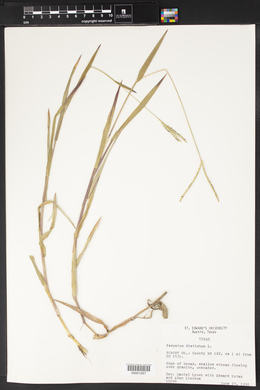Paspalum distichum
|
|
|
|
Family: Poaceae
Jointed Crown Grass, more...knotgrass, knotroot paspalum, Thompsongrass
[Anastrophus paspaloides (Michx.) Nash, moreDigitaria disticha (L.) Fiori & Paol., Digitaria paspalodes Michx., Digitaria paspaloides Michx., Dimorphostachys oaxacensis (Steud.) E. Fourn. ex Hemsl., Milium distichum (L.) Muhl., Milium paspalodes (Michx.) Elliott, Panicum fernandezianum Colla, Panicum paspaliforme J. Presl, Panicum polyrrhizum J. Presl, Paspalum bracteatum Dufour ex Kunth, Paspalum chepica Steud., Paspalum distichum subsp. paspalodes (Michx.) Thell., Paspalum distichum var. digitaria (Poir.) Hack., Paspalum distichum var. indutum Shinners, Paspalum distinctum L., Paspalum elliottii S. Watson, Paspalum fernandezianum Colla, Paspalum michauxianum Kunth, Paspalum oaxacense Steud., Paspalum paspalodes , Paspalum paspalodes var. paspalodes (Michx.) Scribn., Paspalum paspaloides (Michx.) Scribn., Paspalum vaginatum var. pubescens Döll] |
Plants perennial; rhizomatous or cespitose. Culms 5-65 cm, erect; nodes glabrous. Sheaths glabrous, sparsely long pubescent distally; ligules 1-2 mm; blades to 14 cm long, 1.8-11.5 mm wide, flat or conduplicate, glabrous or pubescent, apices involute. Panicles terminal, usually composed of a digitate pair of branches, a third branch sometimes present below; branches 1.4-7 cm, diverging, often arcuate; branch axes 1.2-2.2 mm wide, winged, glabrous, margins scabrous, terminating in a spikelet. Spikelets 2.4-3.2 mm long, 1.1-1.6 mm wide, solitary (rarely paired), appressed to the branch axes, broadly elliptic, stramineous, sometimes partially purple. Lower glumes absent or, if present, to 1 mm and triangular; upper glumes sparsely and shortly pubescent on the back, 3-veined; lower lemmas glabrous, 3-veined; upper florets stramineous. Caryopses 1.9-2.1 mm, yellow. 2n = 20, 30, 40, 48, 60, 61. Paspalum distichum grows on the edges of lakes, ponds, rice fields, and wet roadside ditches. It is native in warm regions throughout the world, being most abundant in humid areas. In the Western Hemisphere, it grows from the United States to Argentina and Chile. FNA 2003, Gould 1980, Kearney and Peebles 1969 Common Name: knotgrass Duration: Perennial Nativity: Native Lifeform: Graminoid General: Perennial grass from extensive creeping stolons; stems erect, 5-65 cm, nodes of both erect stems and stolons usually pubescent. Vegetative: Blades to 14 cm long, 1.5-11 mm wide, flat to folded, glabrous to hairy on upper surface, with involute apices; ligules membranous, 1-2 mm; sheaths glabrous but sparsely pubescent above. Inflorescence: Terminal panicles, composed of a pair of spicate branches, a third branch sometimes present below; branches 1.5-7 cm, diverging, often arcuate, attached to the stem apex not more than 1 cm apart; spikelets 3-4.5 mm long, 1 mm wide, appressed to the branch axes, elliptic lanceolate, glabrous, with 2 florets, the lower sterile and the upper bisexual; lower glume absent; upper glume and sterile lemma glabrous to sparsely puberulous, 3-veined; fertile lemma smooth, shiny, pointed, slightly shorter than the spikelet. Ecology: Found in moist soil along streams or lakes, or in shallow water from 200-6,000 ft (61-1829 m); flowers June-October. Distribution: Native to warm climates throughout the world; in N. Amer. from WA and ID, south to CA, east to NJ, south through MEX to S. Amer. Notes: Found mostly in riparian areas in wet soil and sometimes floating in water; distinguished by being a spreading, rhizomotous and extensively stoloniferous perennial (P. dilitatum is mostly erect and taller with knotty bases and without extensive stolons); pubescent nodes; and glabrous spikelets (P. dilitatum spikelets are hairy) which are tightly appressed in 2 rows along the spike, often with purple stigmas sticking out. P. distichum usually has 2 spicate branches per panicle, while P. dilatatum usually has 3-5 branches. Ethnobotany: Unknown Etymology: Paspalum is from the Greek paspalos for millet, while distichum means in two-ranked. Synonyms: Digitaria paspaloides, Paspalum distichum var. indutum, Paspalum paspaloides Editor: SBuckley 2010, FSCoburn 2015, AHazelton 2015 Stoloniferous; culms 2-5 dm, ascending from a creeping base with conspicuous sheaths; lf-blades relatively short, 2-8 cm נ2-5 mm, ciliate at base; racemes 2, one sessile, the other short-stalked, ascending and often incurved, 2-5 cm, the rachis 1-1.5 mm wide; spikelets solitary, 2.6-3 mm, half as wide, plump, planoconvex, ovate; first glume often developed, triangular, to 1 mm; second glume 5-veined, minutely pubescent, this and the sterile lemma somewhat leathery; 2n=40, 48, 60. Swamps, wet ground, and waste places, often in coastal salt-marshes; mainly in subtropical and warm-temperate regions throughout the world, n. in our range to Ky. and se. Va., and adventive to N.Y. There is some controversy as to whether the name P. distichum should apply to our sp. or to the closely related, more tropical plant usually called P. vaginatum Sw.; in the latter case, our plants take the name P. paspalodes (Michx.) Scribn. Gleason, Henry A. & Cronquist, Arthur J. 1991. Manual of vascular plants of northeastern United States and adjacent Canada. lxxv + 910 pp. ©The New York Botanical Garden. All rights reserved. Used by permission. |
|
|
|
























































































